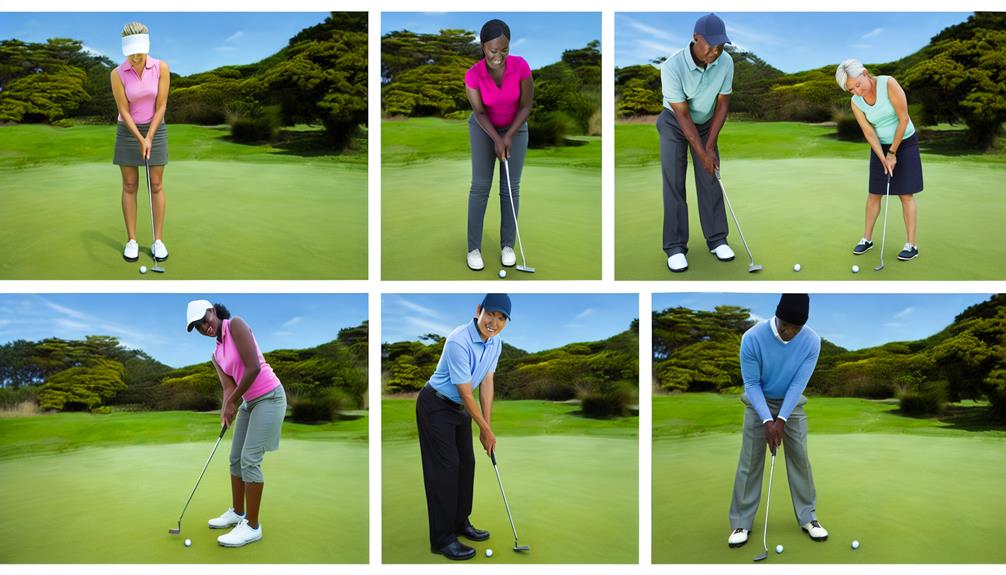Honing your golf putting stroke is like fine-tuning a musical instrument; it requires precision, practice, and a discerning ear, or in this case, eye.
You're likely familiar with the frustrations that can come from missed putts, but with a few adjustments, you can turn those near-misses into victorious holes-in-one.
We're going to examine six crucial rules to refine your putting stroke. From understanding the fundamentals to mastering the stroke itself, each rule will serve as a stepping stone on your path to becoming a more proficient putter.
So, what could be the first rule that holds the key to that coveted smooth, consistent stroke? Let's find out.
Understanding Golf Putting Basics
To master the art of golf, you've got to get a solid grip on putting basics, the core aspect that can make or break your game. Putting techniques aren't just about hitting the ball; it's a strategic blend of precision, power, and position. You've got to understand that the golf ball's direction, distance, and speed are primarily determined by your putting stroke.
Now, let's talk about equipment choice. A putter that fits your style and physique is crucial in making successful strokes. A shorter putter means more control, but less power, while a longer one offers the opposite. Weight is another factor to consider. Heavier putters help maintain a smooth stroke, while lighter ones allow more speed.
Understanding the green's slope and grain is also part of the putting basics. A ball tends to move towards the direction of the grain, especially on faster greens. Remember, you're not just playing against opponents, but also the course itself.
Mastering the putting basics takes time, practice, and patience, but once you've got them down pat, you'll see a significant improvement in your overall game. The key is to never stop learning and adjusting.
The Importance of Grip Strength
Honing your grip strength is essential in golf, as it directly affects the control and power of your putting stroke. It's the core of your swing, and without a solid grip, your shot can easily go awry.
But how do you develop this strength? The answer lies in two words: Grip Conditioning.
Grip Conditioning involves a series of Hand Exercises designed to improve your golf grip. These exercises don't require any fancy equipment. All you need is a small, soft ball and a couple of minutes each day. By regularly squeezing this ball, you'll gradually build up the strength in your hand and forearm muscles.
You're probably wondering if this really works. Well, it does. A stronger grip provides better control over your club, leading to more accurate shots. It also helps reduce the risk of injuries, as a stronger grip puts less strain on your wrists.
Proper Alignment for Putting
Ever wondered about the secret to a perfect putting alignment in golf? Well, it's not as elusive as you might think. The trick lies in two key areas: posture correction and eye positioning.
Posture correction is crucial for a reliable putting stroke. You've got to ensure your body is lined up correctly with the target. Stand tall, relax your shoulders, and position your feet shoulder-width apart. Tilt at your hips, not your waist, keeping your spine straight. This stance provides stability and helps you swing the putter on the correct path.
Eye positioning, on the other hand, is all about how you align your eyes over the ball. Ideally, they should be directly over or just inside the ball. This allows for a consistent, square stroke. If your eyes drift outside the ball, you're likely to pull your putts, while if they're too far inside, you'll probably push them.
Mastering the Putting Stroke
With the right alignment in place, you're ready to refine your putting stroke, a crucial skill in lowering your golf scores. Mastering the putting stroke involves two critical elements: Putter selection and mental preparation.
Putter selection is a highly personal choice and plays a significant role in your putting stroke. The weight, design, and length of the putter should feel comfortable in your hands and suit your body size. A well-chosen putter can enhance your feel and control on the greens, leading to more successful putts.
On the other hand, mental preparation is just as important as physical technique. You should clear your mind of distractions and concentrate solely on the putt ahead. Envision the path your ball will travel and focus on the speed needed. A calm, focused mind can make the difference between a missed putt and a successful one.
Incorporating Speed and Distance Control
While mastering the putting stroke is fundamental, you can't overlook the importance of incorporating speed and distance control in your game. This is where tempo techniques and precision practice play a crucial role.
To start with, tempo techniques involve maintaining a consistent pace for your stroke. It's not about how fast or slow you swing, but rather the rhythm you establish. The pace of your backswing should match that of your forward swing. This consistency helps you better control the speed of your putt, leading to more accurate distance control.
Now, let's talk about precision practice. This means focusing on fine-tuning the length of your backswing and follow-through. The longer your backswing, the further the ball will travel. By practicing different backswing lengths, you'll learn how to gauge the distance of your putts more accurately.

